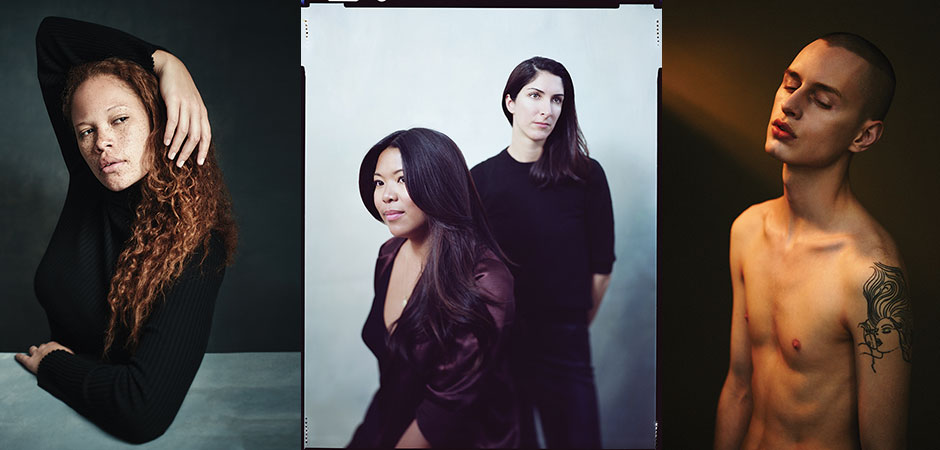Tips + Techniques
Shape Shifting
I started off with a Profoto strobe and a medium Photek umbrella that was set up about 3 feet from the subject, Sabina. The light was a little strong when pointed directly at her, so I slightly feathered the light off of her and away from the background to soften it even more.
I noticed that the right side of the background was a little bright, so I knocked it down by cutting the top right side of the Photek with a black flag. This blocked the light from hitting the background to create an in-camera vignette.
After that, I noticed that the table and Sabina’s shoulder were too bright. I wanted to create an even subtler vignette, so I cut the key light using a one-stop 2 x 3-foot diffusion. Now, only Sabina’s face was getting hit with the light full power.
And last but not least, I added a little black negative to the left side of her face, just out of frame, for a little contrast.
Camera: Nikon D800
Lens: NIKKOR 50mm
Exposure: f/5.6 at 1/125th of a sec
ISO: 100
Lighting: Profoto light with Acute 2400 pack, Photek umbrella, 2 x 3-foot diffusion, black flag, black panel
Warming Aura
I love to start with a broad light source and then chip away at it, or add elements if necessary.
I started lighting this image utilizing the massive loft window behind me. From there, I added a key light to camera left, coming from slightly behind the subject to give more shape and pop. But here’s the trick to this image: The key light was a Profoto strobe, however I only used the model light because the actual strobe would have overpowered the window light. I also enjoyed the light quality coming from the warm continuous model light that was mixing with the cool window fill light. I often let colors play out without being too rigid in using gray cards.
My inspiration for this image came from one of my favorite classic painters, Caravaggio, so I added a Profoto background light, again only using the model light, to make it look as though there was a warm street light slipping into the frame from the top left corner. I used a black flag to cut the bottom of the light to create that hard line.
Camera: Nikon D800
Lens: NIKKOR 50mm
Exposure: f/4 at 1/60th of a sec
ISO: 400
Lighting: Profoto lights with Acute 2400 packs, black flag, black panel
Duo Diffusion
I was assigned to shoot Jen Rubio and Steph Korey, co-founders of the travel lifestyle company Away, for Fast Company. We were at the Away offices near Astor Place in Manhattan, in a room where they do smaller product photography. Luckily, the space had a large, north-facing window with tall ceilings. It was just big enough to fit a 7-foot background, two lights and our bodies. Space is always limited when shooting on location in New York City, but it’s fun to utilize what’s given because it can often make your lighting unique.
I knew ahead of time that I wanted the light to feel effortless while complementing my subjects and the background. We set up the background on the east wall, and we metered the window light to get a reading that would be the key side fill light. I then added an ARRI hot light slightly camera left. The hot light was put through a one-stop 2 x 3-foot diffusion to soften and spread the light, and it acted as my key light. The image was looking a little heavy, so I aimed a Profoto strobe into the white ceiling and wall at camera right to fill in the shadows and even out the difference between the cool window light and the warm tungsten light. This strobe also brought the overall exposure up a full stop, which was needed because the film was rated at ISO 100.
Most people would cringe at the idea of mixing window light, hot lights and strobes because they’re all different color temperatures. It’s okay for me as long as there’s a balance and you color-correct for your subjects’ skin while letting the rest of the colors do what they want. I also knew that the 4 x 5 film would handle the mixed light well and would only add to the film effect.
When it came time to take the photo, I did a slight rear lens-tilt to blur the bottom of their torsos and a small front lens swing to achieve focus in the eyes of both people.
Camera: Sinar F1 4 X 5
Large Format Lens: 150mm
Exposure: f/5.6 at 1/125th of a sec
ISO: 100 Kodak E6 4 X 5
Film Lighting: Arri ST1 Studio 1Kw Fresnel, Profoto strobe, 2 X 3-foot diffusion
Chris Callaway is a New York-based fashion and portrait photographer who was born and raised in rural Oklahoma.
Related: Three Up-Close Portrait Studies With Studio Lighting
Tom Sanders Breaks Down How He Uses Lighting to Match a Portrait’s Mood
Christ Knight Breaks Down His Cinema and Art-Inspired Lighting Scenes











